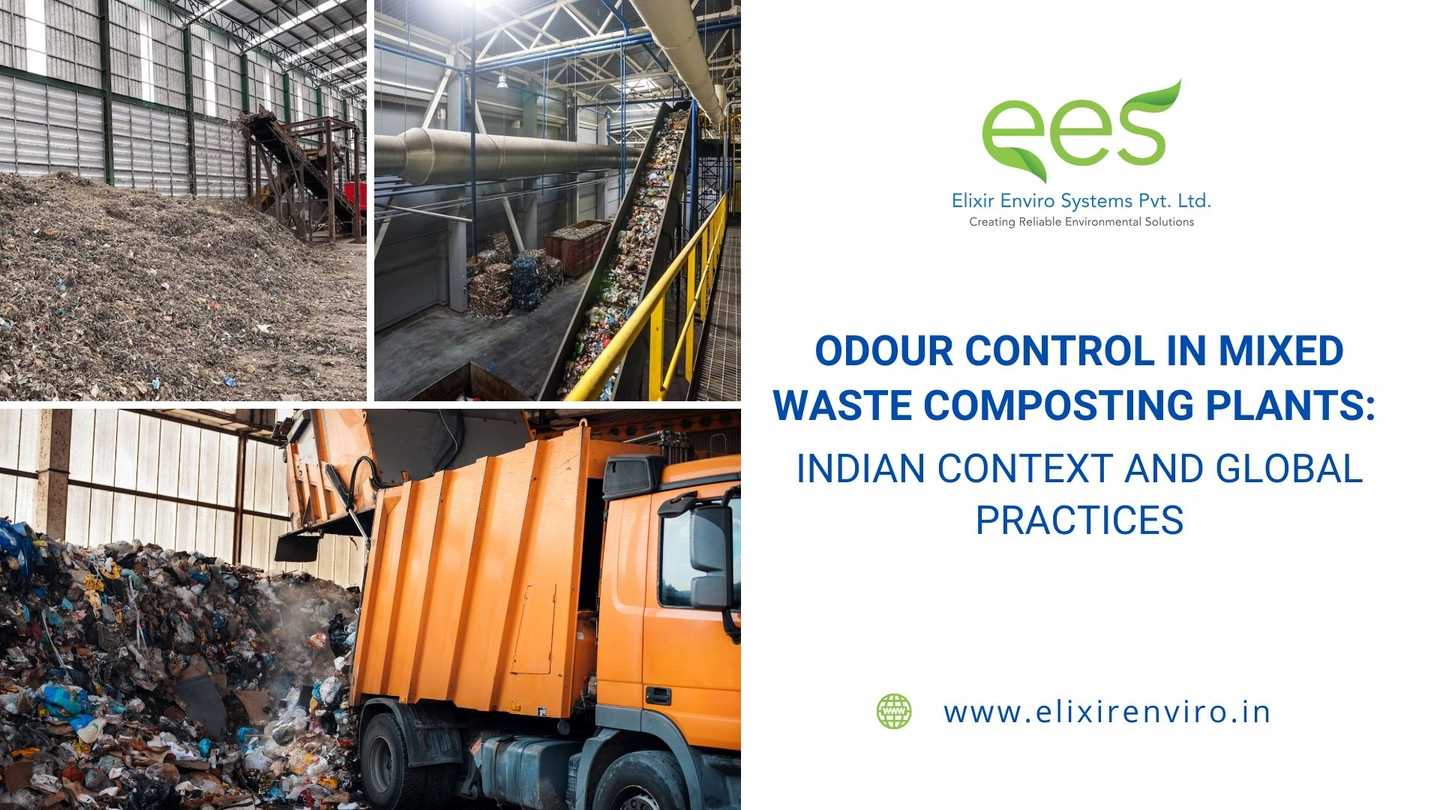Odour Control in Mixed Waste Composting Plants: Indian Context and Global Practices
Introduction
Municipal solid waste (MSW) composting is an important way to manage the large amount of organic waste in India, where organic matter makes up 60 to 70% of total waste. This process turns organic materials into nutrient-rich compost, providing a sustainable waste management option. However, composting produces smelly compounds that can create environmental and public health issues, especially in India’s crowded urban areas. The use of mechanical equipment like trommels, belt conveyors, and large reception pits in Indian composting facilities makes odour emissions worse due to more waste handling and exposure. Effective control of odours is essential for successful operations and community support. This document details the characteristics of mixed waste in India, identifies key odorous compounds, outlines Indian regulations for odour control, describes global odour control practices, explores odour control technologies, and highlights effective strategies.
Characteristics of Mixed Waste in India
Municipal solid waste in India consists of 60 to 70% organic material. This includes food waste, vegetable peels, garden trimmings, and other biodegradable items. The rest includes recyclables such as paper, plastic, glass, and metals, along with hazardous household waste like batteries, paints, and chemicals, as well as inert materials such as sand, grit, and construction debris. The waste has a high moisture content, often over 50%, due to wet organic waste like kitchen scraps. It also has a low calorific value of 800 to 1,000 kcal/kg, which makes composting a better option than thermal processing. The quick breakdown of the organic part, along with the high moisture and poor airflow, leads to anaerobic conditions. This creates unpleasant smells during decomposition, especially in large pits where waste is stored before processing.
Odorous Compounds in Mixed Waste Composting
The decomposition of organic matter in MSW composting generates various odourous compounds due to microbial activity under varying oxygen conditions. Key compounds include:
- Volatile Organic Compounds (VOCs): These include alcohols (e.g., ethanol), aldehydes (e.g., acetaldehyde), and ketones (e.g., acetone),. They form when carbohydrates and proteins break down and create strong, solvent-like smells.
- Ammonia (NH₃): Released during the decomposition of nitrogen-rich materials such as food waste and manure, ammonia produces a sharp, irritating odour, especially in high-pH environments.
- Hydrogen Sulfide (H₂S): Formed under low-oxygen conditions, hydrogen sulfide emits a characteristic rotten egg smell. This odour is common in poorly aerated compost piles or reception pits.
- Mercaptans: Organic sulfur compounds such as methyl mercaptan produce a strong, skunk-like odour, resulting from the anaerobic breakdown of proteins.
- Volatile Fatty Acids (VFAs): Compounds such as acetic, propionic, and butyric acids are produced during anaerobic fermentation, contributing to sour or rancid odours.
- Amines: Compounds like trimethylamine, derived from protein degradation, produce fishy or ammonia like smells.
These compounds are released during waste handling, preprocessing (e.g., trommel screening, conveyor transport), and storage in reception pits, requiring targeted odour control measures.
Indian Regulations for Odour Control in MSW Composting
The Ministry of Environment, Forest and Climate Change (MoEF&CC) notified the Solid Waste Management Rules, 2016, which regulate the management of MSW in India for urban agglomerations, census towns, notified industrial townships, and other such areas. Major provisions for odour control are:
- Source Segregation: The regulations require source segregation of waste into biodegradable, non-biodegradable, and hazardous types in order to minimize contamination, enhance quality of compost, and reduce odour-generating substances. For example, plastics and metals can be used to hold moisture, forming anaerobic micro-environments that release volatile fatty acids (VFAs), hydrogen sulfide (H2S), and mercaptans to some but not the only cause of odour production.
- Standards for Processing: Urban local governments (ULBs) need to set up composting or bio-methanation plants for biodegradable waste, with controlled conditions to restrict odours. Plants must have sanitary conditions and control emissions properly.
- Standards of Quality for Compost: Schedule II defines standards for compost so that it is free from harmful substances, indirectly controlling odours by encouraging good processing practices.
- Monitoring and Compliance: ULBs should report to the Central Pollution Control Board (CPCB) by April 30 of every year about compliance with waste treatment and odour control. The CPCB compiles these reports for the Central Government on or before December 15 every year.
- Environmental Protection: The regulations focus on avoiding environmental pollution, such as odour release, through handling and processing waste appropriately. Treatment facilities with over 5 metric tonnes of waste per day must be approved by the State Pollution Control Board (SPCB) and must have provisions for odour control.
The technical guidelines of the CPCB suggest aeration, control of moisture, and technologies such as biofilters to control odours. Inconsistent follow-up due to financial limitations, infrastructural constraints, and lack of awareness leads to ongoing odour issues, especially in centres with big reception pits. Nevertheless, it is practically difficult to control the odour with the change in process only.
Global Odour Control Practices in MSW Composting Facilities
Globally, MSW composting facilities use process optimization and advanced technologies to manage odours, especially in systems with mechanical equipment and reception pits:
- Process Optimization: Maintaining aerobic conditions through aeration (e.g., aerated static piles with blowers) and controlling moisture levels (50–60%) minimize anaerobic decomposition. Source separation and mechanical screening reduce contaminants, improving feedstock quality and reducing odours. For reception pits, forced aeration and rapid turnover are essential.
- Technological Interventions: Enclosed systems like in-vessel composting contain odours, while air treatment technologies capture and treat emissions from preprocessing and pits. Enclosed trommels and conveyors with negative-pressure systems are standard in developed countries, with extracted air treated using various technologies.
Odour Control Technologies
Biological Odour Control Units
Biological systems use microbial activity to break down odorous compounds. They provide cost-effective and sustainable solutions:
- Biofilters: These systems use organic materials to absorb and break down VOCs, ammonia, and H2S. They achieve 85 to 95% odour removal efficiency. Biofilters work well for treating air from enclosed trommels, conveyors, and reception pits. They need moisture control for the media and require media replacement every 3 to 5 years.
- Biotrickling Filters: These use synthetic packing materials that get irrigated with nutrient-rich liquid to support the breakdown of pollutants by microbes. They effectively handle high concentrations of ammonia and H2S, reaching 90 to 98% removal efficiency. Their compact design makes them suitable for enclosed preprocessing areas. However, they require a constant supply of water and nutrients, which increases costs.
- Bio-scrubbers, These systems channel odorous air through a liquid medium filled with microorganisms that break down pollutants. They achieve 80 to 90 percent efficiency for water-soluble compounds like ammonia. Bioscrubbers can handle high odor loads, but they need a lot of energy for air and liquid circulation. They also require a dedicated water treatment system, which limits their use in places with limited resources.
Non-Biological Odour Control Units
Non-biological systems are utilized for pungent smells or where biological systems are unavailable:
- Chemical Scrubbers: Wet scrubbers utilize chemical solutions (sodium hydroxide, sulfuric acid) to neutralize ammonia and H2S with 85–95% removal efficiency. They can be used in reception pit and preprocessing air but require expensive chemical inputs and maintenance.
- Activated Carbons Filters: These adsorb VOCs and other odor-causing compounds and, when used alone or in combination with biofilters, are 90–99% effective. They are suitable for polishing biologically treated air but need frequent replacement, so they are expensive.
- Thermal Oxidation: Burning of the malodourous gases at elevated temperatures (800–1200°C) with almost complete odour annihilation. Used in large plants where a lot of odour is generated but is energy intensive and generates secondary emissions, so usage is limited.
- Plasma Technology: Non-thermal plasma systems use high-energy electrons to break down odorous molecules, achieving 85–95% efficiency. They are emerging technologies suitable for compact facilities but are costly and require technical expertise and are generally comes with very expensive annual maintenance cost for the electrode replacement and thereby higher operational costs, limiting the use in large facilities.
Combination Treatments for Odour Control
Combining odour control technologies enhances efficiency and addresses a broader range of compounds:
- Biofilter + activated carbon filter: Biofilters deliver primary VOCs, ammonia, and H2S treatment with 85–95% removal, and polishing the remaining odours using activated carbon filters to 95–99% total efficiency. This occurs in enclosed trommel and reception pit plants with optimal cost and performance.
- Biotrickling Filter + Chemical Scrubber: Biotrickling filters remove high levels of ammonia and H2S (90–98% efficiency), and chemical scrubbers remove remaining acid or alkaline gases, 95% total efficiency. It is suitable for high-odour-load plants but increases the cost of operations.
- Biofilter + Thermal Oxidation: This combination is generally used in facilities having separate streams of odour with extremely high intensity odour and moderate indensity odour. the high intensity odour is treated in the thermal oxidation stage as this will reduce high dependence on the secondary fuel, achieving near-complete removal. Whereas the odour from the moderate sources will be handled in Biofilters (85–95% efficiency). This is used in large-scale facilities with stringent regulations but is energy intensive.
- Chemical scrubber + Activated Carbon Filter: Ammonia and H2S are scrubbed out by chemical scrubbers (85–95% effective), with the best removal with activated carbon filters for VOCs, providing 95–99% total effectiveness. This is appropriate for plants with multiple odour sources but is costly in terms of replacement requirements for chemicals and carbon.
These blends are designed according to the character and volume of the odour of the plant, with air from trommels, reception pits, and conveyors blown to the main treatment unit (e.g., biofilter) and then to a secondary unit (e.g., activated carbon) for further removal.
Elixir Enviro Systems: Your Partner in Odour Control for Composting Plants
At Elixir Enviro Systems, we specialize in designing and delivering comprehensive odour control solutions tailored for municipal solid waste (MSW) composting plants across India. With deep domain expertise in biological air treatment and solid waste handling, we offer:
✅ Biological Odour Control Units
- Biofilters: Engineered for high odour removal efficiency (85–95%), ideal for reception pits, trommels, and conveyor enclosures. Our biofilters use specially selected media for longer lifespan and consistent performance.
- Biotrickling Filters: Compact and highly effective for treating high concentrations of ammonia and H₂S, with up to 98% removal efficiency. Designed for enclosed preprocessing zones and pit ventilation systems.
- Bioscrubbers: Liquid-phase biological systems for high-load applications, particularly effective in treating water-soluble odorous compounds.
✅ Non-Biological & Hybrid Systems
- Chemical Scrubbers: High-efficiency wet scrubbers for tough odour streams, especially from reception pits and shredders.
- Activated Carbon Filters: For VOC polishing and secondary treatment stages, especially useful after biological filtration.
- Hybrid Systems: Combining technologies like Biofilter + Carbon Filter or Biotrickling Filter + Chemical Scrubber for comprehensive odour coverage across all process stages.
✅ Comprehensive Services
- Odour Mapping & Onsite Assessment: We conduct detailed odour audits and dispersion modeling to identify emission hotspots and quantify odour loads.
- Custom System Design & Turnkey Execution: From engineering to commissioning, we provide end-to-end odour control system solutions customized to plant layout, budget, and odour profile.
- Annual Maintenance & Performance Monitoring: Our AMC services include media replacement, efficiency testing, and performance tuning to ensure regulatory compliance and system longevity.
Conclusion
Odour control in mixed waste composting plants is a serious concern in India because of high organic load, non-segregation, high moisture, and use of mechanical systems like trommels, conveyors, and large reception pits. Segregation, effective processing, and emission control are mandated under the Solid Waste Management Rules, 2016, but the gaps in implementation persist because of non-availability of resources. Significant odourous compounds like VOCs, ammonia, H2S, mercaptans, VFAs, and amines are released during handling of wastes, and specific interventions like enclosed preprocessing, aeration, and pit management are necessary. Internationally, technologies like in-vessel composting, biological systems (biofilters, biotrickling filters, bioscrubbers), and non-biological systems (chemical scrubbers, activated carbon filters, thermal oxidation, ozone treatment, plasma technology) are useful in odour control, and combination treatments enhance efficiency. For India, using low-cost biological technologies like biofilters, along with better segregation, pit aeration, and enclosing mechanical systems, may improve odour control and support sustainable composting operations.
FAQ
Q1: Why does municipal solid waste composting produce strong odours?
Municipal solid waste composting involves the decomposition of high-moisture, organic-rich waste. Under anaerobic conditions—often caused by poor aeration or excess moisture—this generates volatile organic compounds (VOCs), ammonia, hydrogen sulfide (H₂S), volatile fatty acids (VFAs), and other malodorous gases.
Q2: What are the main sources of odour in Indian composting plants?
The key sources include large reception pits with poor ventilation, trommel screening equipment, and open conveyor systems. These areas facilitate anaerobic conditions and release odorous compounds during waste handling and storage.
Q3: What is the best odour control technology for MSW composting in India?
Biological systems like biofilters and biotrickling filters are the best in cost terms for Indian conditions. They provide high odour removal efficiency (85–98%) with relatively lower running cost, especially when combined with appropriate enclosures and pit aeration systems.
Q4: Are Indian composting plants required to control odour under law?
Yes. The Solid Waste Management Rules, 2016, control odour by proper segregation of waste, standards for processing, and measures for controlling emissions. A permission from the State Pollution Control Boards is required for plants with more than 5 metric tonnes per day with special provisions for odour control.
Q5: Can process adjustments alone eliminate odour emissions?
No. While process improvement like aeration and moisture control reduces odour formation, odour formation cannot be eliminated. Effective odour control relies on the application of a combination of biological or chemical treatment processes, equipment enclosures, and efficient management of sound reception pits.





